Grey Butcherbird
- December 6, 2023
- 0 comment
Grey Butcherbird(Cracticus torquatus), It is a medium-sized songbird native to Australia. The pied butcherbird is known for its striking black and white plumage, as well as its bold and aggressive behavior. It is a common bird in urban and suburban areas, and is often seen perching on power lines or fences.
Physical Appearance

Grey Butcherbird
- Lifespan: 20 years
- Habitat: Forests, Woodlands, and Grasslands. Where they are often seen perching on power lines or fences.
- Diet: Insects, Small Mammals, Reptiles, and Amphibians. They will also eat fruit and nectar.
- Size: 23 to 40 cm
- Weight: Between 100 and 280 grams
- Wingspan: 37 and 55 cm
- Conservation Status: Least Concern.
- Population Trend: The population of the Australian butcherbird is declining in some parts of its range due to habitat loss and fragmentation. However, the population is stable or increasing in other parts of its range.
Grey Butcherbirds are social birds and are often seen in pairs or small groups. They are territorial birds and will defend their territory from other birds. They are also very vocal birds and will often sing to attract a mate or defend their territory.
Species Type
The Grey Butcherbird is known for its striking grey plumage and its bold and aggressive behavior. It is a carnivorous bird and its diet consists mainly of insects, small mammals, reptiles, and amphibians. It is also known for its impaling habit, in which it impales its prey on thorns or barbed wire.
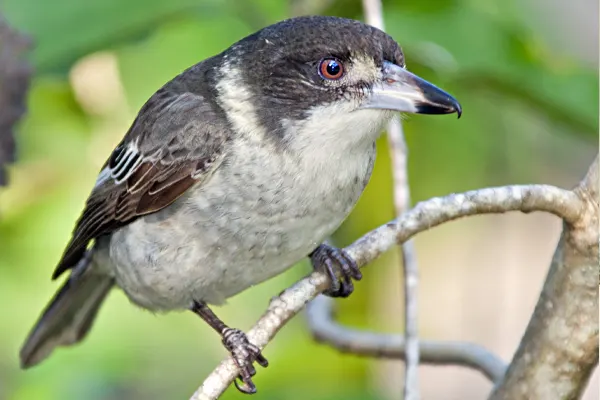
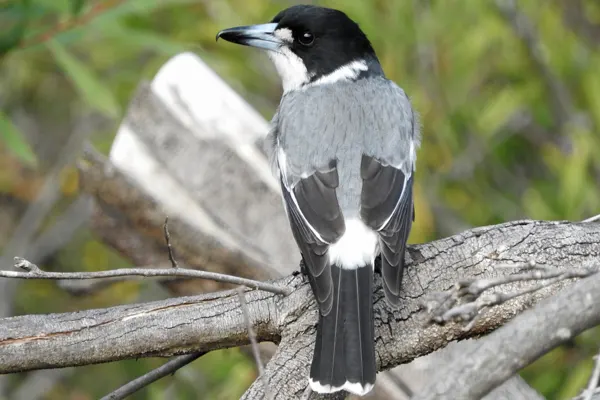
Grey Butcherbirds are social birds and are often seen in pairs or small groups. They are territorial birds and will defend their territory from other birds. They are also very vocal birds and will often sing to attract a mate or defend their territory.
Feather Coloration
The Grey Butcherbird (Cracticus torquatus) exhibits a striking combination of grey, white, and black plumage. The overall tone of its plumage is pale to medium grey, particularly on the back, wings, and underparts. A distinctive feature is the presence of a broad white collar that encircles the neck, extending from the upper throat to the base of the neck. This white collar contrasts sharply with the grey plumage, making it a prominent visual feature.
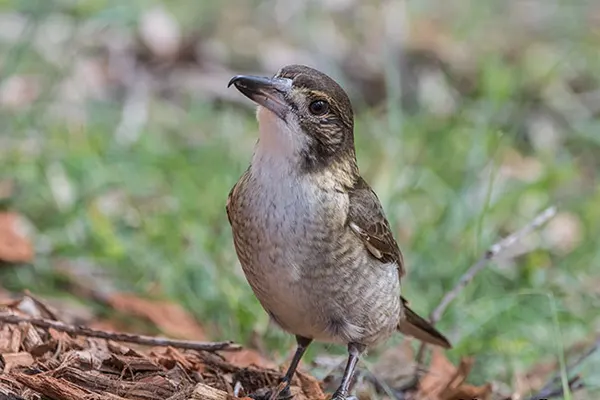

The Grey Butcherbird’s plumage coloration is thought to serve several purposes. The pale grey coloration provides camouflage in its natural habitats, such as woodlands and grasslands. The white collar may play a role in social interactions, attracting mates and signaling dominance. The black markings on the tail and wings may aid in flight display and predator avoidance. The feather coloration of the Grey Butcherbird is an intricate combination of grey, white, and black that serves both functional and aesthetic purposes. It allows the bird to blend into its surroundings, communicate with other individuals, and avoid predators.
Flight Characteristics
The Grey Butcherbird (Cracticus torquatus) is a skilled and versatile flyer, capable of a variety of flight behaviors to navigate its environment and capture prey. It exhibits a direct and purposeful style of flight, characterized by strong wing beats and bursts of speed to pursue its prey.
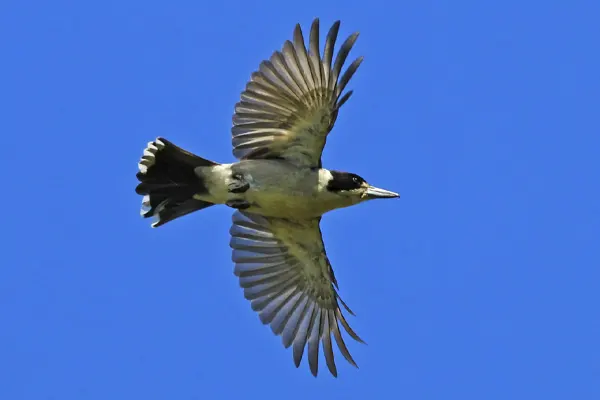
- Take-off and Landing: The Grey Butcherbird takes off with a vigorous upward thrust, often from a perch or the ground. It quickly gains altitude and transitions into a smooth, direct flight. Landing is also controlled, with the bird gradually reducing speed and using its tail feathers to assist in a precise touchdown.
- Maneuverability: The Grey Butcherbird is highly maneuverable, capable of swift changes in direction and quick turns to chase down prey or evade predators. Its relatively short wings provide agility and responsiveness, allowing it to navigate dense vegetation and cluttered environments.
- Speed and Altitude: The Grey Butcherbird is capable of bursts of speed when pursuing prey, reaching speeds of up to 50 kilometers per hour (31 miles per hour). Its typical flight altitude is low to medium, usually within the canopy of trees or just above the ground.
- Soaring and Gliding: The Grey Butcherbird occasionally engages in soaring and gliding, particularly when covering longer distances or conserving energy. It takes advantage of air currents and updrafts to maintain its altitude without expending much effort.
- Perching: When not in flight, the Grey Butcherbird frequently perches on branches, fences, or other elevated structures. It uses its strong feet and claws to grip securely and maintain balance.
- Overall Flight Style: The Grey Butcherbird’s flight style is characterized by its direct, purposeful approach, maneuverability, and ability to take advantage of air currents. Its flight capabilities are well-suited to its lifestyle as a carnivorous bird, enabling it to capture prey and navigate its diverse habitats.
Migration Patterns
The Grey Butcherbird (Cracticus torquatus) is a mostly sedentary species, with limited movement within its range. However, some populations, particularly those in southern Australia, exhibit partial migration patterns. These birds move short distances to warmer regions during the winter months and return to their breeding grounds in the spring.

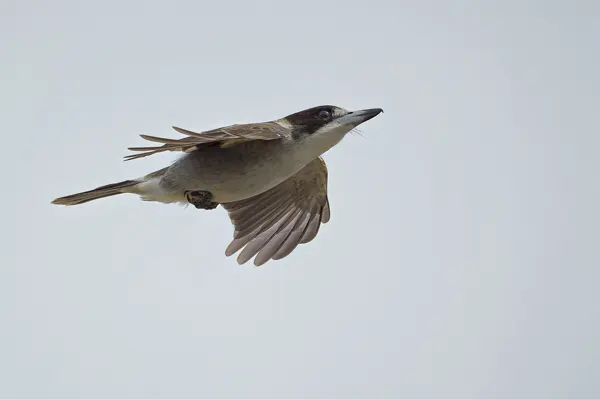
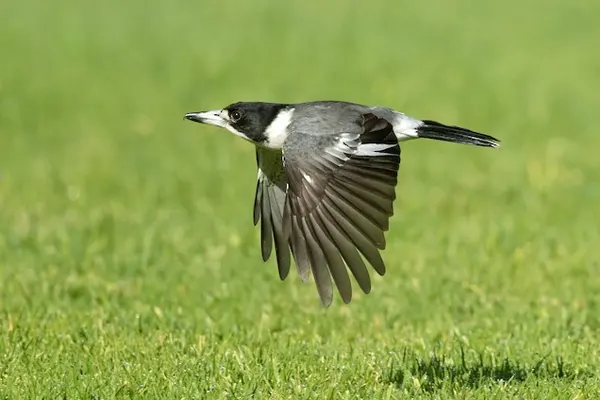
- Migration Patterns in Southern Australia: In southern Australia, some Grey Butcherbirds migrate northwards during the winter, moving from cooler southern regions to warmer northern areas. This migration is primarily driven by the availability of food and suitable habitat. During the winter, insects and other food sources become scarce in southern regions, prompting the birds to seek out more favorable conditions further north.
- Migration Distances: The migration distances of Grey Butcherbirds are relatively short, typically ranging from a few hundred kilometers to a few thousand kilometers. This differs significantly from long-distance migratory birds that traverse vast distances between continents. The Grey Butcherbird’s limited migration pattern reflects its adaptation to local environmental conditions and the availability of resources within its range.
- Return to Breeding Grounds: As the weather warms and food sources become more abundant in southern regions, Grey Butcherbirds begin their return migration to their breeding grounds. This typically occurs in the spring, when conditions are optimal for nesting and raising young.
- Factors Affecting Migration: The extent of migration in Grey Butcherbirds is influenced by various factors, including the severity of winter conditions, food availability, and habitat suitability. In years with milder winters or abundant food sources, the birds may exhibit less movement.
Habitat & Distribution
The Grey Butcherbird is a widespread species found across a wide range of habitats in southern Australia. It is a versatile bird that can adapt to various environmental conditions, thriving in both natural and man-made environments.

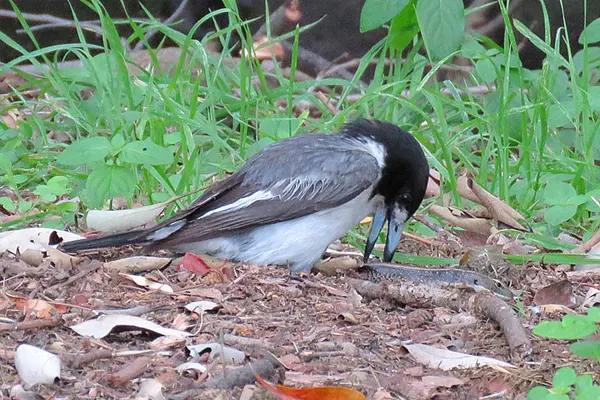
- Forests and Woodlands: Grey Butcherbirds are often found in forests and woodlands, where they utilize trees for perching, nesting, and foraging. They prefer areas with a mix of open and closed canopy, providing them with access to both cover and foraging opportunities.
- Grasslands and Shrublands: Grey Butcherbirds also inhabit grasslands and shrublands, where they hunt for insects and small vertebrates. They are particularly attracted to areas with scattered trees or shrubs, which provide them with nesting sites and perching spots.
- Urban and Suburban Areas: Grey Butcherbirds have successfully adapted to urban and suburban environments, where they thrive in parks, gardens, and residential areas. They are often seen perching on power lines, fences, and rooftops, scanning the surroundings for prey.
Behavioral Traits
Grey Butcherbirds are remarkable birds with a captivating combination of bold behavior, impressive vocalizations, and unique hunting strategies. Their adaptability and intelligence have allowed them to thrive in a variety of habitats, making them an integral part of the Australian ecosystem.
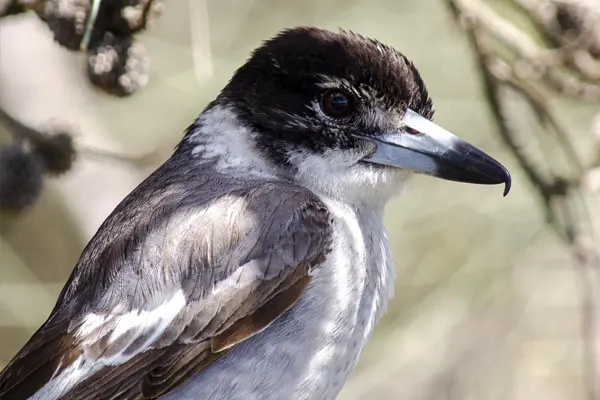
- Bold and Aggressive Behavior: Grey Butcherbirds are renowned for their fearless and assertive nature. They often confront other birds, even larger ones, and will fiercely defend their territory from intruders. This behavior is evident in their erect posture, outstretched wings, and loud vocalizations during confrontations.
- Impaling Habit: A distinctive trait of Grey Butcherbirds is their habit of impaling their prey on thorns, barbed wire, or other sharp objects. This behavior serves multiple purposes. The impaled prey acts as a cache for later consumption, provides a secure way to store excess food, and can be used as a lure to attract mates or defend their territory.
- Vocalizations: Grey Butcherbirds are highly vocal birds, producing a wide range of calls and songs. Their vocal repertoire includes loud, piercing whistles, harsh chatters, and melodious songs. These vocalizations serve various functions, such as attracting mates, defending territory, and communicating with other individuals.
- Territoriality: Grey Butcherbirds are territorial birds, establishing and defending their home ranges against intruders. They use their vocalizations, aggressive displays, and sometimes physical confrontations to protect their territory and resources.
- Social Behavior: While Grey Butcherbirds are primarily territorial, they also exhibit some social behavior. They are often seen in pairs or small groups, especially during the breeding season. They may also form loose flocks during non-breeding periods.
- Hunting Strategies: Grey Butcherbirds are skilled hunters, employing a variety of strategies to capture their prey. They are known for their sally-pouncing technique, where they swoop down from a perch to catch insects or small vertebrates on the ground. They may also stalk prey from a concealed position or ambush unsuspecting individuals.
- Intelligence: Grey Butcherbirds demonstrate intelligence in their behavior. They have been observed using tools, such as sticks and wires, to impale their prey and access food sources. Their ability to adapt to diverse habitats and thrive in human-modified environments further suggests their intelligence and adaptability.
Role in Ecosystem
The Grey Butcherbird plays an important role in the Australian ecosystem as a predator, scavenger, and seed disperser. Its presence helps to regulate populations of insects, small vertebrates, and plants, contributing to the overall balance of the ecosystem.

- Predator: As a carnivorous bird, the Grey Butcherbird preys on a variety of insects, small mammals, reptiles, and amphibians. This helps to control populations of these organisms, preventing them from becoming overabundant and causing harm to plants or other animals.
- Scavenger: Grey Butcherbirds also act as scavengers, consuming dead or decaying animals. This helps to remove carcasses from the environment, preventing the spread of diseases and contributing to nutrient cycling.
- Seed Disperser: Grey Butcherbirds occasionally consume fruits and berries, and some of the seeds pass through their digestive system intact. These seeds are then deposited in new locations, potentially contributing to plant dispersal and regeneration.
- Ecosystem Indicator: The presence or absence of Grey Butcherbirds can serve as an indicator of the overall health of an ecosystem. Their populations are sensitive to changes in habitat quality and food availability, making them valuable indicators of environmental degradation or restoration.
Dietary Habits
The Grey Butcherbird is a carnivorous bird with a diverse diet that consists mainly of insects, small mammals, reptiles, and amphibians. It is an opportunistic predator, adapting its hunting strategies to capture a variety of prey.
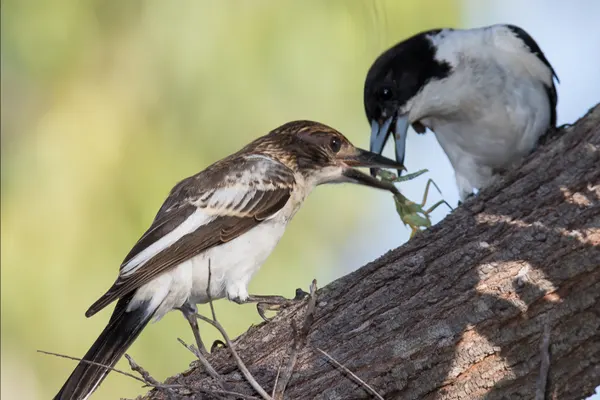
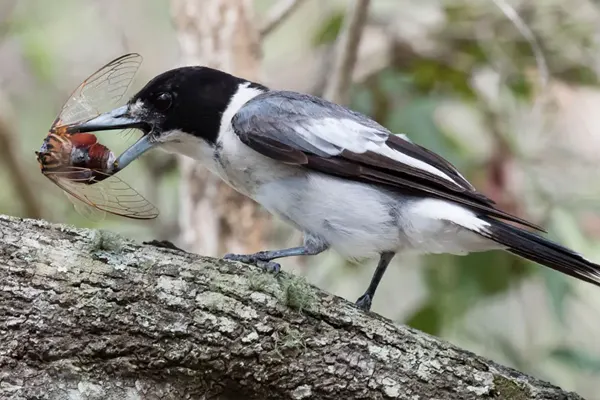
- Insects: Insects form a significant portion of the Grey Butcherbird’s diet, particularly during the warmer months. They readily consume a wide range of insects, including beetles, flies, grasshoppers, caterpillars, and spiders. Their sharp eyesight and agility allow them to capture insects in mid-air or pluck them from vegetation.
- Small Mammals: Grey Butcherbirds also prey on small mammals, such as mice, rats, and bats. They use their strong bills and claws to capture and subdue these prey items. Their bold and aggressive nature enables them to confront even larger mammals on occasion.
- Reptiles: Reptiles, including lizards and snakes, are another important component of the Grey Butcherbird’s diet. They are particularly fond of small lizards, which they can easily capture and consume. Their impaling habit often involves impaling captured reptiles on thorns or barbed wire to secure them for later consumption.
- Amphibians: Amphibians, such as frogs and toads, are also consumed by Grey Butcherbirds. They often capture amphibians in or near water bodies. Their impaling habit can also be used to secure amphibians for later consumption.
- Fruits and Berries: While primarily carnivorous, Grey Butcherbirds occasionally consume fruits and berries. These fruits serve as a supplementary food source, particularly during times when insect and other prey are scarce. Some of the fruits and berries they consume include figs, mulberries, and native Australian fruits.
Interesting Facts
The Grey Butcherbird (Cracticus torquatus) is a fascinating and remarkable bird known for its bold behavior, unique impaling habit, and diverse vocalizations. Captivating bird that continues to fascinate researchers and nature enthusiasts alike. Their unique behavior, remarkable vocalizations, and ecological significance make them an integral part of Australian ecosystems.
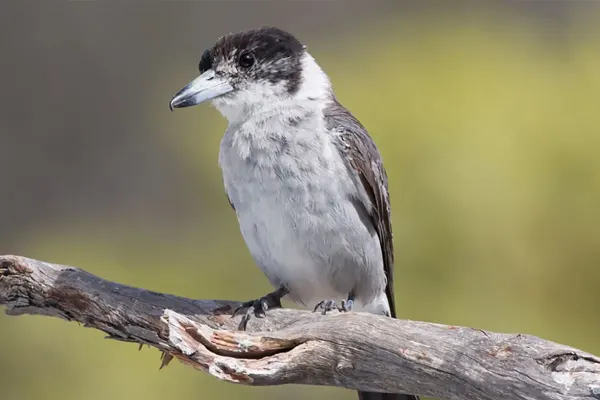
- Impaling Habit: Grey Butcherbirds are renowned for their habit of impaling their prey on thorns, barbed wire, or other sharp objects. This behavior serves multiple purposes, such as storing excess food for later consumption, attracting mates, and defending territory.
- Tool Use: Grey Butcherbirds have been observed using tools, such as sticks and wires, to access food sources or impale their prey. This demonstrates their intelligence and adaptability in utilizing objects from their environment.
- Vocal Mimicry: Grey Butcherbirds possess an impressive ability to mimic the sounds of other birds, animals, and even mechanical devices. This mimicry serves various purposes, such as attracting mates, deceiving prey, and intimidating rivals.
- Urban Adaptation: Grey Butcherbirds have successfully adapted to urban and suburban environments, often seen perching on power lines, fences, and rooftops. Their ability to thrive in human-modified environments speaks to their adaptability and resourcefulness.
- Social Behavior: While primarily territorial, Grey Butcherbirds also exhibit some social behavior. They may form loose flocks during non-breeding periods and occasionally cooperate in defending their territory or capturing prey.
- Hunting Strategies: Grey Butcherbirds employ a variety of hunting strategies to capture their prey. They use their sharp eyesight and agility to catch insects in mid-air or pluck them from vegetation. They may also stalk prey from a concealed position or ambush unsuspecting individuals.
The Grey Butcherbird is a captivating bird that continues to fascinate researchers and nature enthusiasts alike. Their unique behavior, remarkable vocalizations, and ecological significance make them an integral part of Australian ecosystems.
Nesting Habits
Grey Butcherbirds (Cracticus torquatus) are known for their aggressive and territorial behavior, but they also exhibit remarkable nesting habits that ensure the survival of their young.
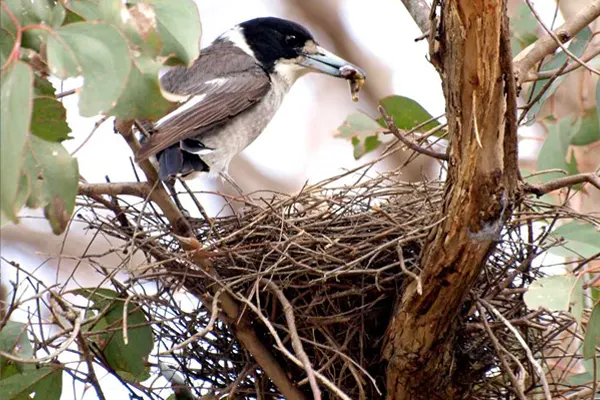
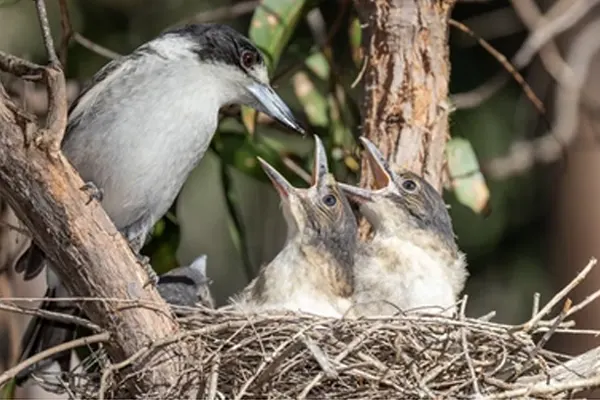
- Nesting Season: Grey Butcherbirds typically breed from July to January, with the peak nesting season occurring in September to November. The timing of breeding is influenced by factors such as food availability and weather conditions.
- Nest Location: Grey Butcherbirds construct their nests in a variety of locations, including trees, shrubs, vines, and even man-made structures like power lines and fences. They prefer to nest in sheltered, well-concealed locations, often within the canopy of trees or dense vegetation.
- Nest Construction: The nest is a shallow, cup-shaped structure made of twigs, leaves, grasses, and other soft fibers. The female takes the primary role in nest construction, carefully weaving the materials together to create a sturdy and comfortable home for her eggs.
- Clutch Size and Incubation: The clutch size of Grey Butcherbirds typically ranges from two to five eggs. The eggs are oval-shaped and vary in color from pale blue to green, often speckled with darker markings. The female incubates the eggs for approximately 25 days, diligently keeping them warm and protected.
- Nestling Care: Both parents share the responsibility of caring for the nestlings, providing them with food and protection from predators. The nestlings hatch blind and helpless, but they grow rapidly and can fledge (leave the nest) within about 28 days.
- Nest Defense: Grey Butcherbirds are fiercely protective of their nests and young. They will aggressively defend their territory against intruders, using their sharp bills and claws to ward off potential threats. Their bold behavior and vocalizations serve as a strong deterrent to predators.
Melodious Song & Vocalizations
Grey Butcherbirds are masters of vocal communication, using their diverse repertoire of calls and songs to navigate their social and ecological world. Their vocalizations play a vital role in their survival, reproduction, and interactions with other species, making them an integral part of the Australian soundscape.
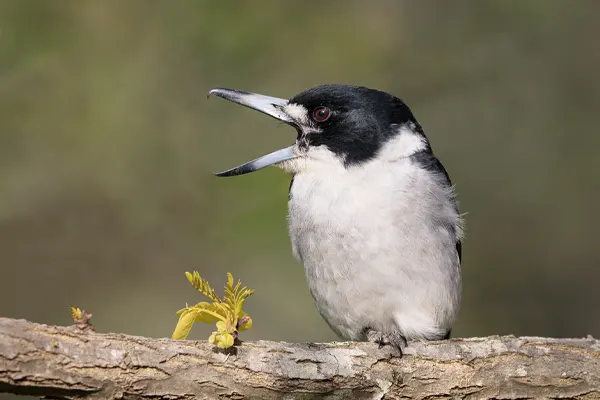
Types of Vocalizations
- Alarm Calls: Sharp, piercing whistles or harsh chatters are used to alert other individuals to potential threats, such as predators or intruders.
- Contact Calls: Short, loud whistles or chattering sounds are used to maintain contact with other individuals, especially within flocks or pairs.
- Territory Defense Calls: Loud, aggressive whistles or harsh chatters are used to defend their territory against intruders, warning other birds to stay away.
- Mate Attraction Songs: Complex and melodious songs, often incorporating mimicry of other bird sounds, are used to attract mates and signal dominance.
- Subsong: A softer, more subdued version of the song, often used during courtship or in quieter moments.
Vocal Characteristics
- Volume: Grey Butcherbirds are known for their powerful voices, producing calls that can be heard over long distances.
- Pitch: Their calls and songs range in pitch, from low, guttural sounds to high, piercing whistles.
- Tempo: The tempo of their vocalizations varies depending on the context, with alarm calls being rapid and agitated while courtship songs are more measured and melodic.
- Mimicry: Grey Butcherbirds are skilled mimics, incorporating sounds from other birds, animals, and even mechanical devices into their vocalizations.
Ecological Significance
The Grey Butcherbird (Cracticus torquatus) plays a significant ecological role in Australian ecosystems, contributing to the balance and stability of various habitats. Its presence impacts various aspects of the ecosystem, including food webs, nutrient cycling, and seed dispersal.
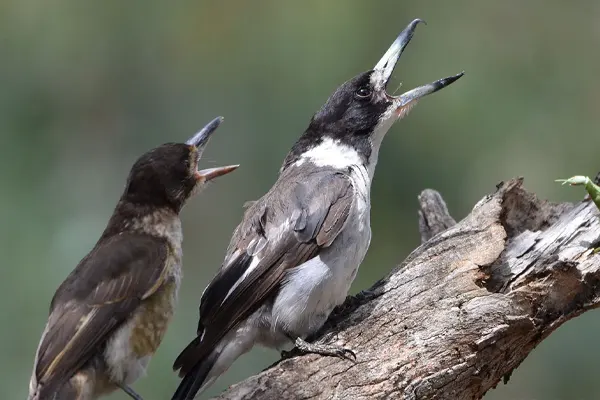
- Predator: As a carnivorous bird, the Grey Butcherbird preys on a wide range of insects, small mammals, reptiles, and amphibians. This helps to regulate populations of these prey species, preventing them from becoming overabundant and causing harm to plants or other animals.
- Scavenger: Grey Butcherbirds also act as scavengers, consuming dead or decaying animals. This helps to remove carcasses from the environment, preventing the spread of diseases and contributing to nutrient cycling.
- Nutrient Transfer: By consuming prey and excreting waste, Grey Butcherbirds contribute to the movement of nutrients within the ecosystem. They transfer nutrients from prey animals to the soil, where they can be utilized by plants.
- Carrion Removal: Their scavenging behavior helps to remove decaying organic matter from the environment, preventing the buildup of excess nutrients and potential imbalances in nutrient cycles.
- Fruit Consumption: Grey Butcherbirds occasionally consume fruits and berries, and some of the seeds pass through their digestive system intact. These seeds are then deposited in new locations, potentially contributing to plant dispersal and regeneration.
- Indirect Seed Dispersal: Their impaling habit can also indirectly aid in seed dispersal. When they impale fruits or berries, the seeds may become dislodged and fall to the ground, leading to the establishment of new plants in new locations.
Conservation Status
The introduction of invasive species, such as feral cats and foxes, can pose a significant threat to Grey Butcherbird populations. These predators can prey on Grey Butcherbirds and their eggs, leading to population decline. Additionally, the introduction of diseases from introduced species can also have a detrimental impact on Grey Butcherbird populations.

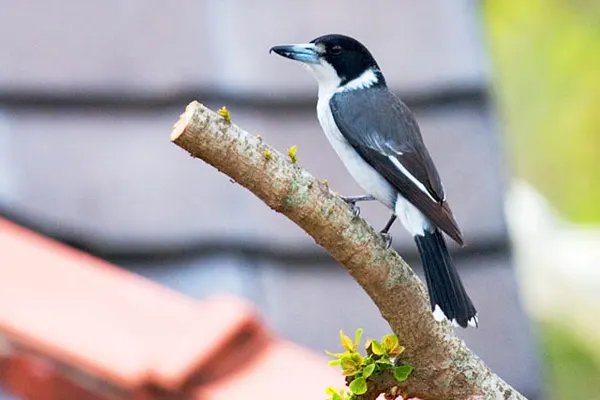
- Habitat Protection: Preserving and restoring natural habitats, particularly woodlands and shrublands, is crucial for maintaining suitable habitat for Grey Butcherbirds.
- Predator Control: Managing populations of invasive predators, such as feral cats and foxes, can help to reduce predation pressure on Grey Butcherbirds.
- Monitoring and Research: Ongoing monitoring of Grey Butcherbird populations and research into their ecology is essential for identifying and addressing threats to the species.
One of the primary threats to Grey Butcherbirds is habitat loss and fragmentation. As urban areas expand and land is cleared for agriculture, the amount of suitable habitat for Grey Butcherbirds decreases. This can lead to population decline, increased competition for resources, and isolation of populations.
Research and Ongoing Studies
These ongoing research efforts are providing valuable insights into the biology, ecology, and conservation of Grey Butcherbirds. By continuing to study this fascinating species, we can gain a deeper understanding of their role in Australian ecosystems and develop effective conservation strategies to ensure their future survival.

- Habitat Use and Selection: Researchers are investigating the habitat preferences of Grey Butcherbirds, identifying the types of habitats they prefer and the factors that influence their habitat selection. This information is crucial for conservation planning and habitat management.
- Dietary Habits and Prey Preferences: Studies are examining the diets of Grey Butcherbirds, identifying the prey species they consume and the seasonal variations in their diet. This information is important for understanding their ecological role and the food webs they support.
- Breeding Ecology and Reproductive Success: Researchers are studying the breeding behavior of Grey Butcherbirds, including nest site selection, parental care, and nestling survival. This information is essential for understanding their reproductive strategies and the factors that affect their breeding success.
- Population Dynamics and Trends: Monitoring programs are in place to track Grey Butcherbird populations over time, identifying trends in abundance and distribution. This information is crucial for assessing their conservation status and identifying potential threats.
- Impacts of Habitat Fragmentation and Urbanization: Researchers are investigating the effects of habitat fragmentation and urbanization on Grey Butcherbird populations. This information is important for understanding how human-induced changes affect their survival and reproduction.
- Genetic Diversity and Population Structure: Genetic studies are being conducted to assess the genetic diversity of Grey Butcherbird populations and identify potential subpopulations. This information is valuable for understanding their evolutionary history and identifying conservation priorities.
- Vocal Communication and Mimicry: Researchers are studying the vocalizations of Grey Butcherbirds, including their repertoire of calls and songs, the functions of different vocalizations, and their ability to mimic other sounds. This information is important for understanding their communication systems and social behavior.
- Responses to Climate Change: Studies are investigating how Grey Butcherbirds are responding to climate change, including changes in their distribution, abundance, and breeding behavior. This information is crucial for understanding their vulnerability to climate change and developing adaptation strategies.
Educational and Ecotourism
The Grey Butcherbird (Cracticus torquatus) is a captivating and ecologically important species that offers a wealth of educational and ecotourism opportunities. Its striking appearance, diverse vocalizations, and fascinating behavior make it an engaging subject for learning about Australian ecosystems and the importance of conservation.
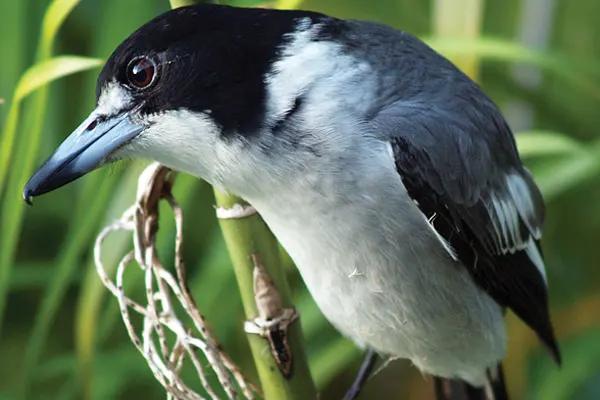
- Educational Opportunities:
- Schools and Nature Centers: Grey Butcherbirds can be incorporated into school curricula and nature center programs to teach students about bird identification, ecology, and conservation. Their unique habits, such as impaling prey and mimicking sounds, can spark curiosity and inspire a love for nature.
- Citizen Science: Engaging the public in citizen science projects can provide valuable data on Grey Butcherbird populations and distribution. Participants can collect observations on bird sightings, behavior, and habitat preferences, contributing to our understanding of the species.
- Educational Resources: Developing educational resources, such as brochures, posters, and online content, can raise awareness about Grey Butcherbirds and their ecological significance. These resources can be used in classrooms, nature centers, and ecotourism sites to inform visitors and foster appreciation for the species.
- Ecotourism Opportunities:
- Birdwatching Tours: Grey Butcherbirds are a popular target for birdwatching enthusiasts, and incorporating them into guided tours can attract visitors to natural areas. Birdwatchers can enjoy observing their distinctive plumage, vocalizations, and behaviors in their natural habitat.
- Wildlife Photography: Grey Butcherbirds offer opportunities for wildlife photography enthusiasts to capture their unique beauty and behaviors. Their bold nature and impaling habit provide captivating subjects for photographers.
- Ecotourism Packages: Incorporating Grey Butcherbird sightings into ecotourism packages can encourage visitors to explore natural areas and learn about the importance of conservation. Combining birdwatching with other activities, such as hiking, camping, or wildlife viewing, can provide a comprehensive ecotourism experience.
The Grey Butcherbird presents a unique opportunity for education and ecotourism, offering valuable learning experiences and contributing to conservation efforts. By promoting ecotourism activities centered around Grey Butcherbirds, we can foster a deeper appreciation for this fascinating species and its role in Australian ecosystems.
Conclusion
The Grey Butcherbird (Cracticus torquatus) is a captivating and ecologically significant species that plays a vital role in Australian ecosystems. Its bold and assertive behavior, unique impaling habit, and remarkable vocal mimicry set it apart from other birds. As a carnivorous predator, it contributes to the regulation of food webs, nutrient cycling, and seed dispersal. Its presence is an indicator of the overall health of an ecosystem, making it a valuable tool for monitoring environmental conditions.
Despite its current Least Concern conservation status, threats such as habitat loss, fragmentation, invasive predators, and climate change pose potential challenges to the long-term survival of Grey Butcherbird populations. Ongoing research efforts are crucial for understanding these threats and developing effective conservation strategies.
Educational and ecotourism opportunities centered around Grey Butcherbirds offer a promising avenue for promoting awareness, inspiring appreciation, and generating support for conservation efforts. By engaging the public in learning about this fascinating species, we can foster a deeper understanding of its place in the Australian environment and encourage responsible stewardship of its habitats.
The Grey Butcherbird stands as a remarkable example of the diversity and resilience of Australian birdlife. Its unique characteristics, ecological importance, and potential for educational and ecotourism make it a species worthy of our attention and conservation efforts. By understanding and appreciating the Grey Butcherbird, we can contribute to the preservation of its natural habitats and ensure its continued role in maintaining the vibrant ecosystems of Australia.




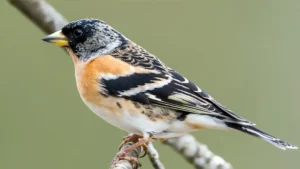
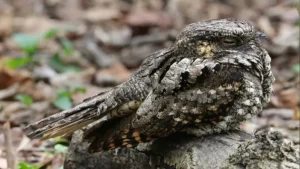

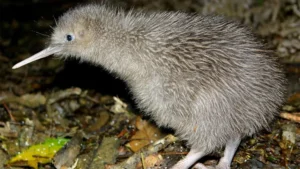

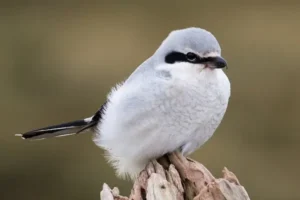



Leave your comment